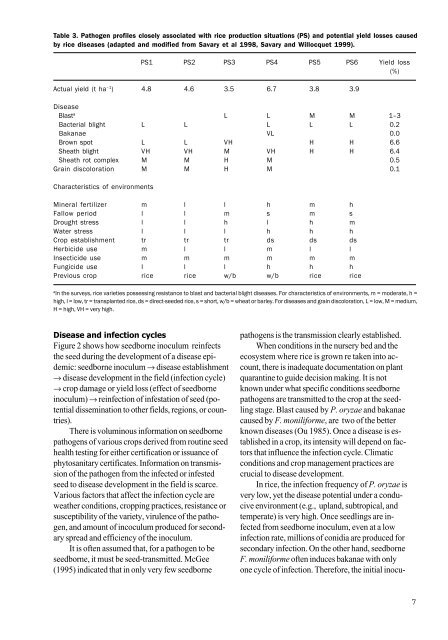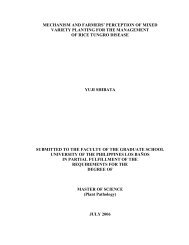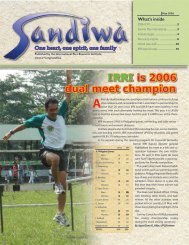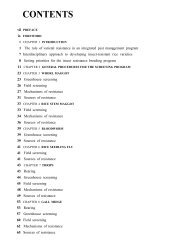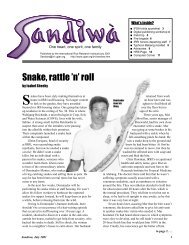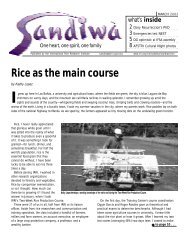Untitled - International Rice Research Institute
Untitled - International Rice Research Institute
Untitled - International Rice Research Institute
You also want an ePaper? Increase the reach of your titles
YUMPU automatically turns print PDFs into web optimized ePapers that Google loves.
Table 3. Pathogen profiles closely associated with rice production situations (PS) and potential yield losses caused<br />
by rice diseases (adapted and modified from Savary et al 1998, Savary and Willocquet 1999).<br />
PS1 PS2 PS3 PS4 PS5 PS6 Yield loss<br />
(%)<br />
Actual yield (t ha –1 ) 4.8 4.6 3.5 6.7 3.8 3.9<br />
Disease<br />
Blast a L L M M 1–3<br />
Bacterial blight L L L L L 0.2<br />
Bakanae VL 0.0<br />
Brown spot L L VH H H 6.6<br />
Sheath blight VH VH M VH H H 6.4<br />
Sheath rot complex M M H M 0.5<br />
Grain discoloration M M H M 0.1<br />
Characteristics of environments<br />
Mineral fertilizer m l l h m h<br />
Fallow period l l m s m s<br />
Drought stress l l h l h m<br />
Water stress l l l h h h<br />
Crop establishment tr tr tr ds ds ds<br />
Herbicide use m l l m l l<br />
Insecticide use m m m m m m<br />
Fungicide use l l l h h h<br />
Previous crop rice rice w/b w/b rice rice<br />
a<br />
In the surveys, rice varieties possessing resistance to blast and bacterial blight diseases. For characteristics of environments, m = moderate, h =<br />
high, l = low, tr = transplanted rice, ds = direct-seeded rice, s = short, w/b = wheat or barley. For diseases and grain discoloration, L = low, M = medium,<br />
H = high, VH = very high.<br />
Disease and infection cycles<br />
Figure 2 shows how seedborne inoculum reinfects<br />
the seed during the development of a disease epidemic:<br />
seedborne inoculum → disease establishment<br />
→ disease development in the field (infection cycle)<br />
→ crop damage or yield loss (effect of seedborne<br />
inoculum) → reinfection of infestation of seed (potential<br />
dissemination to other fields, regions, or countries).<br />
There is voluminous information on seedborne<br />
pathogens of various crops derived from routine seed<br />
health testing for either certification or issuance of<br />
phytosanitary certificates. Information on transmission<br />
of the pathogen from the infected or infested<br />
seed to disease development in the field is scarce.<br />
Various factors that affect the infection cycle are<br />
weather conditions, cropping practices, resistance or<br />
susceptibility of the variety, virulence of the pathogen,<br />
and amount of incoculum produced for secondary<br />
spread and efficiency of the inoculum.<br />
It is often assumed that, for a pathogen to be<br />
seedborne, it must be seed-transmitted. McGee<br />
(1995) indicated that in only very few seedborne<br />
pathogens is the transmission clearly established.<br />
When conditions in the nursery bed and the<br />
ecosystem where rice is grown re taken into account,<br />
there is inadequate documentation on plant<br />
quarantine to guide decision making. It is not<br />
known under what specific conditions seedborne<br />
pathogens are transmitted to the crop at the seedling<br />
stage. Blast caused by P. oryzae and bakanae<br />
caused by F. moniliforme, are two of the better<br />
known diseases (Ou 1985). Once a disease is established<br />
in a crop, its intensity will depend on factors<br />
that influence the infection cycle. Climatic<br />
conditions and crop management practices are<br />
crucial to disease development.<br />
In rice, the infection frequency of P. oryzae is<br />
very low, yet the disease potential under a conducive<br />
environment (e.g., upland, subtropical, and<br />
temperate) is very high. Once seedlings are infected<br />
from seedborne inoculum, even at a low<br />
infection rate, millions of conidia are produced for<br />
secondary infection. On the other hand, seedborne<br />
F. moniliforme often induces bakanae with only<br />
one cycle of infection. Therefore, the initial inocu-<br />
7


